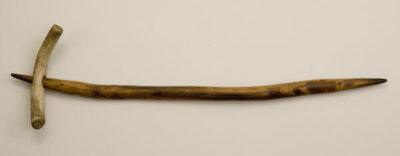Often we can turn to the tools used by our ancestors or indigenous natives to find simple, effective solutions to survival and off-the-grid living. The so-called digging stick is no exception to this rule, and as you will see, the well-equipped survivalist will want to include one of these deceptively simple tools in their bag of tricks.
Anyone who has foraged in the woods knows that a lot of delicious and important foods live underground, and they often form the backbone of a wild food diet. Tubers, bulbs and roots all lurk under the ground, and these starch- and nutrition-packed foods will keep you well-fed and healthy in an off-grid emergency.
The concept of the digging stick is deceptively simple and can be little more than a pointy stick used to help extract roots and tubers from the ground. The tip can be sharpened and fire-hardened for a longer life span, or curved and shaped to serve as a sort of scoop or plow. A crosswise handle also may be fitted to the top to increase leverage and make digging easier.
In a more modern form, a bit of metal can be placed on the tip to improve the useful life of the tool, and help it dig easier. When you realize the digging stick is little more than a pointed and shaped tool designed to make rooting around in the dirt easier, an entire world of possibilities open up.
Get Backup Electrical Power In A Convenient, Portable Briefcase!
But why — you might ask — does the 21st-century world care about one of the most primitive tools ever made? It is precisely because it is a highly primitive tool. It can be made with just your bare hands, or with a simple knife or just a fire. Equally important is that it is a labor- and energy-saving tool. A long-enough stick can be used to dig root vegetables without stooping over, which saves important energy in a survival situation.
To make your own digging stick, start with a sturdy branch or stick that is long enough to be comfortable to use. Taking your knife, trim any leaves or smaller branches off it, and shape the tip the way you like it. Use a simple point for basic digging, or curve it and make a sort of bent spoon shape for digging and light soil cultivation or scraping through soft dirt. Run the end through your fire to lightly char and harden it, and you have a basic digging stick! If you are so inclined to use twine, bark or rope, you can tie a crosswise handle to the top, which increases your leverage.
One additional use of the digging stick can be as a light spear or stabbing weapon, particularly if you can fit it with a metal or stone tip. This expands the utility and moves it into the realm of hunting as well as vegetable foraging. You also can carry fishing line and hooks and adapt your digging stick into a fishing pole, and even use it as a light staff or walking stick.
The digging stick is a very useful off-grid tool, which is probably why it has been independently invented by most primitive cultures. Applying modern, 21st-century thinking to the concept, we can lightly improve on it with modern materials, but the power of the digging stick is in its simple function and very simple construction. One could make a fine digging stick out of a fiberglass rod fitted with a steel tip, and even fit a hollow handle to the top to hold survival gear like matches, a compass, fishing line, etc. But being able to make one in minutes when needed is a handy thing, too.
If you plan to incorporate a digging stick into your survival arsenal, you should make one now and practice with it. It is a primitive skill that seems easy on the surface, but like many such skills requires an odd degree of skill and practice to work properly. Experiment with different lengths and configurations, or take them out and test them in the soil in your area. Discover which shapes of tips work best. Learn to work one without having metal tips, and then once you’ve mastered it, go ahead and make one up for your survival gear, or rest easy knowing you could make and properly use on in a pinch.
Our ancient ancestors were not dummies. They survived in a world with primitive medical care at best, and under conditions that would be taxing for nearly all modern people. Plus, they did so with the crudest and simplest of tools. However, they had their brains, and those brains carried them through. Go ahead and make your digging stick, but hone your mind, as well.
Have you ever made a digging stick? Share your tips in the section below:
 Off The Grid News Better Ideas For Off The Grid Living
Off The Grid News Better Ideas For Off The Grid Living





